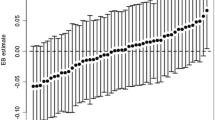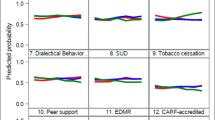Abstract
The authors describe an evaluation of the influences on service access, adequacy, and appropriateness in four capitated public mental health programs. Access, adequacy, and appropriateness were higher than the fee for service programs, suggesting that the financial incentive in capitation was not a significant limiting factor. Access and adequacy were also limited by new program effects as well as by case manager and client preferences.
Similar content being viewed by others
References
Arizona House Bill 2511, Chapter 398. (1986). State of Arizona, House of Representatives, thirty-seventh Legislature, Second Regular Session.
Bachrach, L. (1981). The role of model programs in the care of chronic mental patients. In: J.A. Talbott (Ed.),The chronic mentally ill (pp. 300–314), New York: Human Sciences Press.
Brekke, J. (1987). The model-guided method of monitoring program implementation.Evaluation Review, 11, 281–300.
Brekke, J. (1988) What do we really know about community support programs? Strategies for better monitoring.Hospital and Community Psychiatry, 39, 946–952.
Chamberlain, R., & Rapp, C. (1991). A decade of case management: a methodological review of outcome research.Community Mental Health Journal, 27, 171–188.
Craig, T., & Patterson, D. (1981). A comparison of mental health costs and utilization under three insurance models.Medical Care, 19, 184–192.
Department of Health and Human Services. (1980). Toward a national plan for the chronically mentally ill. Washington, DC: Author.
Diehr, P., Williams, S., Martin, D., & Price, K. (1981). Ambulatory mental health services utilization in three provider plans.Medical Care, 22, 1–13.
Endicott, J., Spitzer, R.F., Fleiss, J.L., & Cohen, J. (1976). The global assessment scale. A procedure for measuring overall severity of psychiatric disturbanceArchives of General Psychiatry, 33, 766–771.
Grusky, O., & Tierney, K. (1989). Evaluating the effectiveness of countywide mental health care systems.Community Mental Health Journal, 25, 3–20.
Human Services Research Institute, KPMG Peat Marwick. (1989)The Arizona Pilot Program evaluation: Capitation analysis Cambridge: Author.
Jacoby, I. (1985). The consensus development program of the National Institute of Health: Current practices and historical perspectives.International Journal of Technology Assessment in Health Care, 1, 420–432.
Leff, H.S. (1987).Pilot program conceptual report: Submitted to the State of Arizona, Division of Behavioral Health Services. Cambridge: Human Services Research Institute.
Leff, H.S., Dada, M., & Graves, S. (1984). An LP planning model for a mental health community support system.Management Science, 32, 139–155.
Leff, H.S., Graves, S., & Elsesser, K. (1991). Model driven approaches to implementation and outcome services research. Manuscript submitted for publication.
Leff, H.S., Graves, S., Natkins, J., & Bryan, J. (1985). A system for allocating mental health resources.Administration in Mental Health, 13, 43–68.
Leff, H.S., Mulkern, V. (1989).Service fit: An approach to implementation evaluation. Cambridge: Human Services Research Institute.
Leff, H.S., Mulkern, V., & Lieberman, M. (1991). Outcome trends in capitated mental health programs. Manuscript submitted for publication.
Lehman, A. (1987). Capitation payment and mental health care: A review of the opportunities and risks.Hospital and Community Psychiatry, 38, 31–38.
Lehman, A. (1989). Strategies for improving services for the chronically mentally ill.Hospital and Community Psychiatry, 40, 916–920.
Lehtinen, V., Panelius, M., & Tienari, P., (1989). Finnish consensus development conference on the treatment of schizophrenia.International Journal of Technology Assessment in Health Care. 5, 269–281.
Manning, W., Wells, K., & Benjamin, B. (1987). Use of outpatient mental health services over time in a health maintenance organization and fee for service plans.American Journal of Psychiatry, 144, 283–287.
Mauch, D. (1990). The congruence of service utilization and client need: A study of the predictors or fit in a public mental health system. (Doctoral dissertation, Brandeis University, 1990).Dissertation Abstracts International, 51, 4772B, (University Microfilms No. 9106061).
McGlynn, E.A., Kosecoff, J., & Brook, R.H. (1990). Format and conduct of consensus development conferences.International Journal of Technology Assessment in Health Care., 6, 450–469.
McGuire, T. & Fairbank, A. (1988). Patterns of mental health utilization over time in a fee-for-service population.American Journal of Public Health, 78, 134–136.
Mechanic, D., & Aiken, L. (1989). Capitation in mental health. In D., Mechanic & L. Aiken (Eds.),Paying for Services: Promises and Pitfalls of Capitation, 43. San Francisco: Jossey-Bass.
Meichenbaum, D., & Turk, D. (1987).Facilitating treatment adherence. New York: Plenum.
Newman, F. (1980). Global scales: Strengths, uses and problems of global scales as an evaluation instrument.Evaluation and Program Planning, 3, 257–268.
National Institute of Mental Health. (1982).A network for caring: The Community Support Program of the National Institute of Mental Health. Boston, Boston University, Center for Rehabilitation Research and Training in Mental Health.
Report discusses involuntary treatment. (1991, Summer).National Association of Psychiatric Survivors News, pp. 5–7.
Santiago, J. (1987). Reforming a system of care: The Arizona experiment.Hospital and Community Psychiatry, 38, 270–273.
Schalock, R., & Jensen, C. (1986). Assessing the goodness of fit between persons and their environment.Journal of Association of People with Severe Handicaps, 11, 1093–1109.
Scheirer, M., & Rezmovic, E. (1983). Measuring the degree of program implementationEvaluation Review, 7, 599–633.
Schlesinger, M. (1989). Striking a balance: Capitation, the mentally ill, and public policy. In D. Mechanic & L. Aiken (Eds.),Paying for Services: Promises and Pitfalls of Capitation, 43. San Francisco: Jossey-Bass.
Scott, E.A., & Black, N. (1991). When does consensus exist in expert panels?Journal of Public Health Medicine, 13, 35–39.
Scott, E.A., & Sechrest, L. (1989). Strength of theory and theory of strength.Evaluation and Program Planning, 12, 329–336.
Seekins, T., & Fawcett, S. (1984). Planned diffusion of social technologies for community groups. In S. Paine, G.T. Bellamy, & B. Wilcox (Eds.),Human services that work. Baltimore: Brooks Publishing.
Sherman, P. (1987). Simple quality assurance measures.Evaluation and Program Planning, 10, 227–229.
Siegel, S. (1956).Nonparametric statistics for the behavioral sciences. New York: McGraw-Hill Book Company.
Siegel, C., Laska, E., Griffis, A. & Wanderling, J. (1978). Quantitative care norms for a psychiatric population in a county medical assistance program.American Journal of Public Health, 68, 352–358.
Taube, C., Goldman, H., & Salkever, D. (1990). Medicaid coverage for mental illness: Balancing access and costs.Health Affairs, 9, 5–18.
Wells, K., Manning, W., & Benjamin, B. (1986). use of outpatient mental health services in HMO and fee for service plans: Results from a randomized controlled trial.Health Services Research, 21, 453–474.
Williams, S.J., Diehr, P., Drucker, W.L. & Richardson, W.C. (1979). Mental health services: Utilization by low income enrollees in a prepaid group practice plan and in an independent practice, plan.Medical Care, 17, 139–151.
Wortman, P.M., Vinokur, A. & Sechrest, L. (1988). Do consensus conferences work? A process evaluation of the NIH consensus development program.Journal of Health Politics, Policy and Law, 13, 469–498.
Yeaton, W.H. (1985). Using measures of treatment strength and integrity in planning research. In W.H. Yeaton (Ed.),New Directions for Program Evaluation, 27, 49–61.
Author information
Authors and Affiliations
Additional information
This research was supported by the Arizona Division of Behavioral Health Services (ADBHS) and by the National Institute of Mental Health grant 5 R01 MH44878-02-02 to H. Stephen Leff.
Rights and permissions
About this article
Cite this article
Stephen Leff, H., Mulkern, V., Lieberman, M. et al. The effects of capitation on service access, adequacy, and appropriateness. Adm Policy Ment Health 21, 141–160 (1994). https://doi.org/10.1007/BF00707483
Issue Date:
DOI: https://doi.org/10.1007/BF00707483




